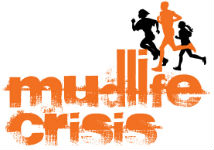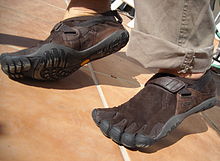I wrote my last post on my personal recommendation for OCR shoes, and my favorite shoe is the Vibram FiveFingers Spyridon LS. And naturally, that has brought out a lot of questions like this:
“But I read that they proved those minimalist shoes were bad for your feet! Why are you recommending these, Jamie?” Excellent question. I don’t think I can walk into a gym without some wiseacre trying to chat me up about how bad he read those were for you. After all, there was a lawsuit about them, right?
Well, yes and no. The lawsuit was about the claims Vibram made about them in their initial marketing for the model – claiming that there was scientific proof that the shoes improved foot strength and health and were safer to run in. It was later decided that there was no proof at the time of the claims, and Vibram was forced to pay claims to people who felt their rights were abused by Vibram.
So while there was no proof that they could help your foot health during the initial marketing campaign, there is evidence today that they can and have helped people. Notice that I said, above, “at the time of the claims.” Doctor Nicholas Campatelli covers this admirably in this blog post.
But here’s the point I think also needs to be made: I am very willing to bet that most people who got hurt with VFFs rushed the process. And that’s where I think there are some serious problems that need to be addressed – many experts will assert that the amount of time that companies like Vibram and VivoBarefoot suggest for the proper adjustment to the minimalist shoe lifestyle is woefully under-stated.
As I recall, three months seems to be the average recommendation for breaking into the shoes. But a lot of that has only to do with the muscle-building portion (getting used to the calf muscle use that accompanies a proper barefoot-style running gait). There’s a whole lot of other stuff that needs to be taken into consideration, and it’s enough that people like Katy Bowman have written entire books on the topic of transitioning to barefoot.
If you will recall my story from my gear recommendation post for OCRs, I had transitioned into Vibram FiveFingers KSOs at the beginning of May, and after some initial calf soreness was doing just fine in them for short runs. I then took the dubious step of trying them out in the Warrior Dash. Warrior Dash Ohio in June, 2011, was a hilly, all-trail run course out in Logan, Ohio, in the Hocking Hills region. Lots of up and down course work, for sure, but all of it was on trails (occasionally gravel-paved trails, but never cement or asphalt). My feet were a bit sore the next day, but not anything I was particularly worried about.
My next race, in July of that year, was the now-defunct Ruckus Race at Crew Stadium in Columbus – not far from my house. It was run in the large parking lot that the Crew shares with the Ohio Expo Center, where the State Fair is held. Ergo, except for the one steep hill that was basically built up from a dry drainage ditch, it was flat – and, in places, it was paved.
The race was also a mile longer than the 5K Warrior Dash. The day was hot, and being in a parking lot area, it was also totally unshaded. Ergo, I got a lot more tired in this race than I did at Warrior Dash. And, as I did, my running form started breaking down and I started to occasionally heel strike as a break from holding the strong mid-foot strike form that minimalist shoes require.
That was where things went wrong once the race was over. I felt fine during the race other than fatigue, but a few hours afterward I stood up to walk somewhere and my heels literally flared up with pain. I had strained my Achilles tendons pretty badly doing what I did. I was on crutches the rest of the weekend and for a couple days at work while the inflammation went away. And to be frank, I was haunted by that pain for a year or so afterward.
The thing that truly ended the pain for me was taking the step of removing all padded and heeled shoes from my closet as much as I could. I switched to VivoBarefoot shoes for my everyday wear – models like the Hind (a boat-shoe type model) and the Gobi (the VivoBarefoot chukka boot model) were what I switched to for work, and their original Achilles sandal and their Ultra for everything summery. Even when I had to wear boots, I used Neos Overshoes with the VivoBarefoot shoes inside to keep that zero-drop heel for as much time as I could.
That did the trick – walking and just living all the time in minimalist shoes seems to be what saved me from further injury like that I felt when I was switching back and forth from VFFs to my Sketchers or whatever I was wearing for work at the time. Now I can run indefinitely in minimalist shoes on hardtop and have no issues.

I’m convinced that people like Katy Bowman and her compatriots in the world of restorative movement have the right idea: as she said on an episode of Robb Wolf’s The Paleo Solution podcast (episode 224), the guidelines on Vibram’s website and other places simply aren’t good enough or explicit enough. Bowman has now written a whole book simply on the topic of this transition and a series of exercises to go along with it, called Whole Body Barefoot: Transitioning Well to Minimal Footwear.
The point to remember is that hurrying this process and not doing things the right way is going to be a hazard down the road, one way or another. Wearing shoes your entire life is basically putting a cast around each of your feet. And even though that cast causes problems for runners and other athletes (things like plantar fasciitis, runner’s knee, shin splints, and many of the common running injuries), a too-quick transition can lead to other problems. As Bowman says in the podcast above, people think they’re starting at 100% when they start that transition – but they’re actually at about 15% of the full function they’d enjoy had they started with barefoot as their baseline.
So take it easy. Don’t be afraid of minimalist shoes, but go into the process with the idea that yes, you can resolve your running injuries with Vibrams or other minimalist shoes, but you can also cause other problems if you don’t do things gradually.







